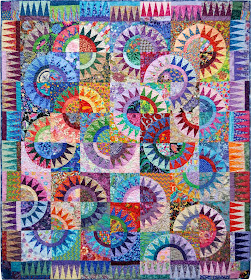 |
| I like to call this quilt the "Box of Crayons" Quilt |
The third quilt documented on Tuesday is one I like to call the "Box of Crayons" quilt. I got the name from a friend who said it reminded her of a box of crayons because of the multicolored points. We could probably call this 1940s quilt a New York Beauty, since it was made during the time the name was widely in use. However, the specific pattern source doesn't appear to be the Mountain Mist pattern. There are several key differences.
 |
| 1930s Mountain Mist New York Beauty |
Here's what the 1930s Mountain Mist New York Beauty looks like. In comparison, the "Box of Crayons" quilt has narrower and longer points, more of them, multicolor rather than single-color, with the tips of the colored points touching the outer edge of the curved quarter-circle arc, rather than radiating from the arc. The cornerstones are not a match. In the Mountain Mist quilt, they are Le Moyne stars. In the "Box of Crayons" quilt, they are nine-patches. There are no arcs in the outer corners of the Mountain Mist quilt, but there are in the other. So, the pattern source is unknown but it's still possible the maker called it a New York Beauty.
The quilt that seems most closely related visually, is a quilt that appeared on the cover of Quilter's Newsletter Magazine in April, 1998. There's not much information about the quilt and its maker, but there is a short blurb below the Editor's Letter.
 |
| Click photo for enlarged view. |
On our cover -- AUSTIN BEAUTY, 68" x 68", made by Laurie Evans of Austin, Texas. Laurie likes to work in bright colors and was inspired by the beautiful lakes and hot sun of the Austin area. She loves the New York Beauty block pattern and said, "I just wanted to use it." Laurie drafted her own pattern. The points in the blocks and sashing were paper pieced, the paper torn away and the top completed by machine piecing. It is machine quilted. Austin Beauty has been exhibited in several venues, including the International Quilt Festival in Houston, Texas, and the American Quilter's Society show in Paducah, Kentucky.
Laurie Evans probably hadn't seen the "Box of Crayons" quilt when she made her Austin Beauty, but the the two are visually connected. The double rows of points in her quilt, the sunburst cornerstones, and scalloped edge finish add to the level of difficulty in this already-challenging design. And just like some of the other widely exhibited and published quilts from the 1930s forward, Evans' quilt reinforced the name recognition of New York Beauty. By the mid-to-late 1990s, the name was so deeply ingrained in quilting circles there was an abbreviation, "NYB", and many spin-offs that used part of the name, such as Austin Beauty.
 |
| An early, scrappy rendition of a variation on the pattern |
Before the 1990s, the New York Beauty in all its variations had not been a scrappy quilt often. In the 19th century, it was made almost exclusively of well-matched, solid color fabrics. The earliest scrappy version in my collection was included in the August/September, 2012 issue of Quilters Newsletter as an intermediate pattern. The c. 1910 variation was called "Suspension Bridge" and many other names such as "Broken Circle" and "Sunflower".
The thing that puts this quilt in the New York Beauty family is the basic block design: four quarter-circles with radiating points on the outer curves, each wedged into an inside corner of a parallelogram. Throughout the history of the pattern, there had been a movement toward simplification and streamlining. The "Suspension Bridge" quilt, for example, included no piecework in the sashing or cornerstones. Of course, everything would change in the 1990s.
 |
"Lady Liberty Goes to Hawaii" a Karen Stone Pattern,
made by Marita Wallace of San Diego, California, 2011 |
The foundation piecing seen in the Quilters Newsletter article was introduced to the New York Beauty pattern in the 1990s by artists such as Jean Wells and Karen Stone. These artists ushered in a big wave of new variations, with innovative designs and vibrant fabrics. From that point forward, it was no longer uncommon to see a multitude of brightly colored fabrics in these quilts.







This comment has been removed by a blog administrator.
ReplyDeleteOops, sorry, I was trying to remove spam comments and removed real comments by mistake. Blogger won't let me repost those comments. :P
ReplyDelete